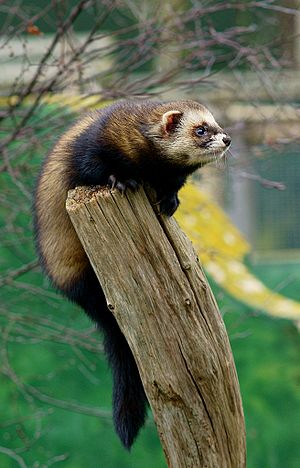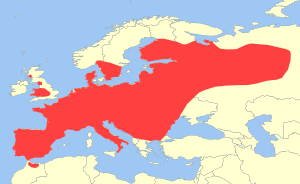European polecat facts for kids
Quick facts for kids European polecatTemporal range: Middle Pleistocene – Recent
|
|
|---|---|
 |
|
| A Welsh polecat at the British Wildlife Centre | |
| Conservation status | |
| Scientific classification | |
| Genus: |
Mustela
|
| Species: |
putorius
|
 |
|
| Geographic range | |
The European polecat (Mustela putorius) is a type of mustelid animal. It lives in western Eurasia and northern Morocco. People also call it the common ferret, black or forest polecat, foumart, or fitch. It has dark brown fur, a light-colored belly, and a dark mask on its face. Sometimes, you might see polecats with different colors, like albinos. This animal family also includes minks and other weasels.
Compared to other mustelids, the polecat has a shorter, more solid body. Its skull and teeth are stronger, and it is not as quick or agile. Polecats are famous for spraying a very smelly liquid. They use this liquid to mark their home area.
Contents
What is a European Polecat?
The European polecat is a medium-sized mammal. It belongs to the weasel family. It is known for its strong smell. This smell comes from glands near its tail. They use this scent to tell other animals where their territory is.
Appearance and Features
Polecats have a unique look. They have dark brown fur on most of their body. Their belly is usually lighter. A dark mask covers their eyes. This mask makes them easy to spot. Sometimes, polecats can be born with different fur colors. These include very light or even white fur.
Where Do Polecats Live?
European polecats live in many places. You can find them across western Eurasia. They also live in northern Morocco. They prefer areas with forests and grasslands. They often live near water sources.
Their Home Range
Unlike some other animals, polecats are not very territorial. This means they often share their living areas. Polecats of the same sex might even share their home ranges. This is different from many other mustelids.
What Do Polecats Eat?
Polecats are carnivores, meaning they eat meat. They hunt small animals. Their diet mainly includes small rodents like mice and voles. They also eat birds, amphibians like frogs, and reptiles like lizards.
Hunting and Storing Food
Polecats are clever hunters. They sometimes injure their prey without killing it. They might bite the prey's brain to make it unable to move. Then, they store the living animal in their burrow. This way, they have fresh food for later.
Life Cycle and Reproduction
European polecats are polygamous. This means one male can mate with several females. Females become pregnant after mating. They do not need a special trigger for ovulation.
Kits and Independence
Polecats usually give birth in early summer. A group of baby polecats is called a litter. A litter can have five to ten kits. These young polecats grow quickly. They become independent when they are about two to three months old.
History and Conservation
The European polecat first appeared in Western Europe. This was during the Middle Pleistocene period. Its closest living relatives are the steppe polecat and the black-footed ferret. The European mink is also a close relative.
Hybrids and Relatives
European polecats can have babies with steppe polecats. They can also breed with black-footed ferrets. Their offspring are fertile. This means these babies can have their own babies. Polecats can also breed with minks. However, these hybrid babies are usually sterile. This means they cannot have their own babies. These polecat-mink hybrids are often larger. Their fur is also more valuable.
Polecats and Humans
The European polecat is the ancestor of the ferret. Ferrets were tamed over 2000 years ago. People used them to hunt small pests. For a long time, people did not like polecats. In the British Isles, gamekeepers often hunted them.
Even today, polecats are not very well-known. They are not often seen in popular culture. Some people in rural areas still misunderstand their behavior. However, the IUCN has good news. 2008, the European polecat is listed as Least Concern. This is because they have a wide range and large numbers.
Names for the Polecat
The European polecat has many different names. People in different places have called it by various names.
English Dialect Names
Many old English names exist for the polecat. In southern England, it was often called 'fitchou'. In the north, people used 'foumat' or 'foumart'. There were also many other names. Some examples include 'philbert', 'fulmer', and 'poll cat'. One expert found at least 20 different names in just one area!
Latin Name Meaning
The scientific name for the polecat is Mustela putorius. This name also refers to its smell. The Latin word putorius means "stench" or "stink". This is where the English word putrid comes from.
Images for kids
-
A Scottish polecat guarding a rabbit from a least weasel, painted by Archibald Thorburn
-
A common polecat attacking a grey partridge, displayed at the Bulgarian National Museum of Natural History
-
Polecat skins (fitch) in Copenhagen
-
Buffon's illustration of a polecat
See also
 In Spanish: Turón para niños
In Spanish: Turón para niños
















